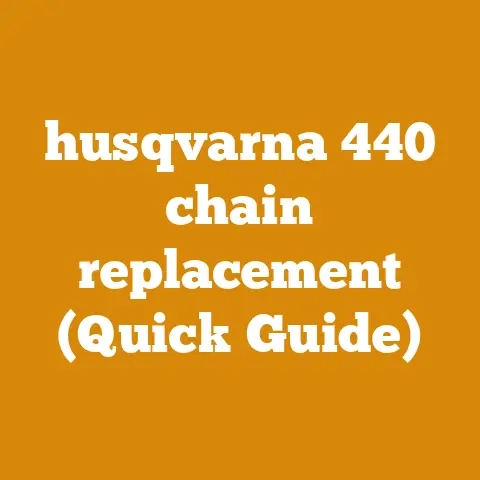Stihl 025 Specs (5 Performance Upgrades)
I remember the first time I picked up a Stihl 025.
My father handed it down to me with a few words of wisdom: “Take care of this tool, and it will take care of you.” That chainsaw has been my companion on countless projects, from felling trees to cutting firewood.
It’s not just a machine; it’s a testament to durability and reliability.
Have you ever relied on a tool that felt like an extension of yourself?
That’s exactly what the Stihl 025 is for me.
Understanding the Stihl 025
Let’s break down the fundamentals of this chainsaw to understand why it’s so beloved in the community.
The Stihl 025 is packed with features that make it both powerful and user-friendly.
It’s perfect for various applications, whether you’re a weekend warrior or a full-time lumberjack.
Key Specifications
- Engine Displacement: 45.4 cc
This displacement ensures that the saw has enough power to handle medium-sized trees with ease. - Power Output: 2.8 hp
With this level of horsepower, the Stihl 025 can cut through wood efficiently without bogging down. - Bar Length: Typically 16 to 18 inches
The common bar lengths provide versatility for different cutting tasks. - Weight: Around 10 lbs (without bar and chain)
Lightweight yet robust, making it easy to maneuver for extended periods.
Diving Deeper into Performance Upgrades
To get the best performance out of your Stihl 025, let’s explore five upgrades that can transform your chainsaw into a true powerhouse.
These enhancements not only improve efficiency but also extend the lifespan of your tool.
1. Upgrading the Chain
A sharp chain is crucial for effective cutting.
Over time, even the best chains can dull, affecting performance.
Upgrading to a high-quality chain can make a noticeable difference.
Storytime: I once worked on a project clearing storm-damaged trees.
My old chain kept getting stuck, wasting precious daylight.
After switching to a professional-grade full chisel chain, not only did the work progress faster, but it also required less effort on my part.
- Step-by-Step Guide:
- Step 1: Select a high-quality chain that matches your bar length.
Make sure it’s compatible with your saw’s specifications. - Step 2: Remove the old chain by loosening the tensioner and taking off the guide bar nuts.
- Step 3: Carefully fit the new chain onto the guide bar, ensuring it’s properly aligned.
- Step 4: Adjust tension correctly; the chain should not sag but also shouldn’t be too tight.
- Step 1: Select a high-quality chain that matches your bar length.
Safety Tip: Always wear gloves when handling chains to prevent cuts and injuries.
2. Switching to a High-Performance Air Filter
The air filter is an often overlooked component that plays a vital role in engine performance.
A high-performance air filter allows for better airflow, enhancing power and efficiency.
Personal Insight: Back when I was new to chainsaws, I ignored my air filter maintenance.
One hot summer day, my saw sputtered and died mid-cut.
Lesson learned: never underestimate the importance of clean air intake!
- Step-by-Step Guide:
- Step 1: Remove the top cover by unscrewing the fasteners.
- Step 2: Take out the old air filter, noting any debris or dirt buildup.
- Step 3: Clean the surrounding area thoroughly to prevent contaminants from entering.
- Step 4: Install the new high-performance filter, checking that it fits snugly and securely.
Warning: Never run your chainsaw without an air filter as this can introduce harmful particles into the engine, causing severe damage.
3. Installing a Compression Release Valve
For those who struggle with starting their chainsaw, particularly in cold conditions, a compression release valve can be a game-changer.
It reduces starting effort by lowering cylinder pressure during startup.
Experience Sharing: During a particularly frigid winter, I found myself struggling to start my saw in sub-zero temperatures.
Installing a compression release valve made those mornings much less frustrating.
- Step-by-Step Guide:
- Step 1: Access the cylinder cover by removing necessary bolts.
- Step 2: Carefully drill an appropriate-sized hole for the valve (consult your manual for exact measurements).
- Step 3: Thread the valve into place securely.
Caution: This modification requires precision.
If you’re not confident in your mechanical skills, seek professional assistance to avoid potential engine damage.
4. Upgrading to a Carburetor with Adjustable Jets
The carburetor controls the fuel-air mixture entering the engine.
An adjustable carburetor allows for fine-tuning, optimizing performance under various conditions.
Insightful Anecdote: I remember struggling with inconsistent performance during altitude changes on a mountain job.
After upgrading to an adjustable carburetor, my saw ran smoothly whether I was at base camp or near the summit.
- Step-by-Step Guide:
- Step 1: Remove air filter and cover to access the carburetor.
- Step 2: Detach old carburetor by loosening screws and disconnecting fuel lines carefully.
- Step 3: Install the new adjustable carburetor, ensuring all connections are secure.
- Step 4: Adjust jets gradually while testing performance until optimal settings are achieved.
Tip: Make small adjustments and test frequently to avoid engine flooding or lean conditions which can harm your saw.
5. Enhancing Muffler for Better Exhaust Flow
Improving exhaust flow can lead to increased engine power and efficiency.
Modifying or replacing your muffler can achieve this enhancement.
Personal Story: On one occasion, my chainsaw lost power halfway through a job.
After investigating, I found carbon buildup in the muffler restricting airflow.
Enhancing my muffler not only restored performance but improved it beyond its original state.
- Step-by-Step Guide:
- Step 1: Detach current muffler by unscrewing bolts carefully.
- Step 2: Either modify existing muffler to enhance flow or replace it with a high-flow aftermarket option.
- Step 3: Reattach securely; ensure no exhaust leaks are present by testing operation.
Safety Warning: Ensure modifications comply with local noise regulations and environmental standards to avoid penalties or issues with neighbors.
Safety Precautions
Chainsaws are incredibly powerful tools that demand respect and caution during use.
Here are some critical safety precautions that I always adhere to:
- Wear personal protective equipment (PPE) at all times, including gloves, eye protection, hearing protection, and sturdy boots.
- Conduct a pre-use inspection of your chainsaw for any signs of damage or wear.
- Maintain a clear working area free of obstructions and ensure no bystanders are in proximity during operation.
- Follow proper starting procedures: place the chainsaw on firm ground with adequate footing before engaging.
- Avoid cutting above shoulder height; maintain control over saw at all times during operation.
Prerequisite Knowledge and Materials
Before embarking on these upgrades, ensure you have basic mechanical skills and familiarity with chainsaw components.
Required Knowledge:
- Understanding of engine mechanics
- Familiarity with chainsaw safety protocols
Required Materials:
- New chain compatible with bar length
- High-performance air filter
- Compression release valve suitable for model
- Adjustable carburetor kit
- Enhanced muffler or modification kit
Troubleshooting Tips
Even the best upgrades can encounter issues.
Here are some troubleshooting tips for common problems:
- Chainsaw Won’t Start: Check fuel lines for blockages or leaks; verify all connections are secure; ensure spark plug is clean and functioning.
- Performance Drop After Upgrades: Inspect air filter for clogs; re-evaluate carburetor settings; verify no exhaust leaks from muffler.
- Unusual Noises During Operation: Examine muffler installation for gaps or loose fittings; inspect chain tension and alignment regularly.
Conclusion and Next Steps
By embracing these upgrades on your Stihl 025 chainsaw, you’ll witness significant improvements in performance and efficiency—transforming an already reliable tool into an indispensable powerhouse that meets diverse cutting needs effectively.
Once you’ve completed these enhancements successfully apply them across various wood types—testing results firsthand as each upgrade becomes second nature over time spent working alongside upgraded equipment!
FAQ Section
Q: Can I perform these upgrades myself? A: Most upgrades are manageable with basic mechanical knowledge—though consulting professionals remains advisable if unsure/confident regarding specific tasks involved (e.g., modifying mufflers).
Q: How often should I replace air filters? A: Inspect filters after every ten hours’ usage; replace whenever dirty/damaged ensuring uninterrupted airflow throughout operations performed utilizing equipment effectively thereafter!
Q: Will modifying my chainsaw void its warranty? A: Certain modifications may void warranties depending upon manufacturers’ terms/conditions outlined within documentation provided—consult manufacturer directly prior undertaking extensive alterations/modifications affecting original design/functionality significantly enough impact coverage offered initially purchased product received intact/unmodified form supplied originally delivered accordingly!





